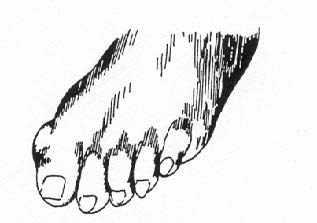The Musculoskeletal System
Lesson 2: Diseases and Disorders of the Feet
Section IV: Arthritis of the Feet
2-26
2-26. PES CAVUS (CLAWFOOT)
In this condition, the longitudinal arch is abnormally high. The result is that the toes may curl under in what is described as a "clawfoot" (see figure 2-14).
a. Signs/Symptoms of Clawfoot. Included are the following:
(1) Pain in the metatarsals.
(2) Callus formation.
(3) Shortened Achilles tendon.
Figure 2-14. Pes cavus (clawfoot).
b. Treatment of Clawfoot. Place a foam rubber bar across the insole just behind the metatarsal heads. In severe cases, surgery may be necessary.


